2006 DODGE RAM SRT-10 display
[x] Cancel search: displayPage 4996 of 5267
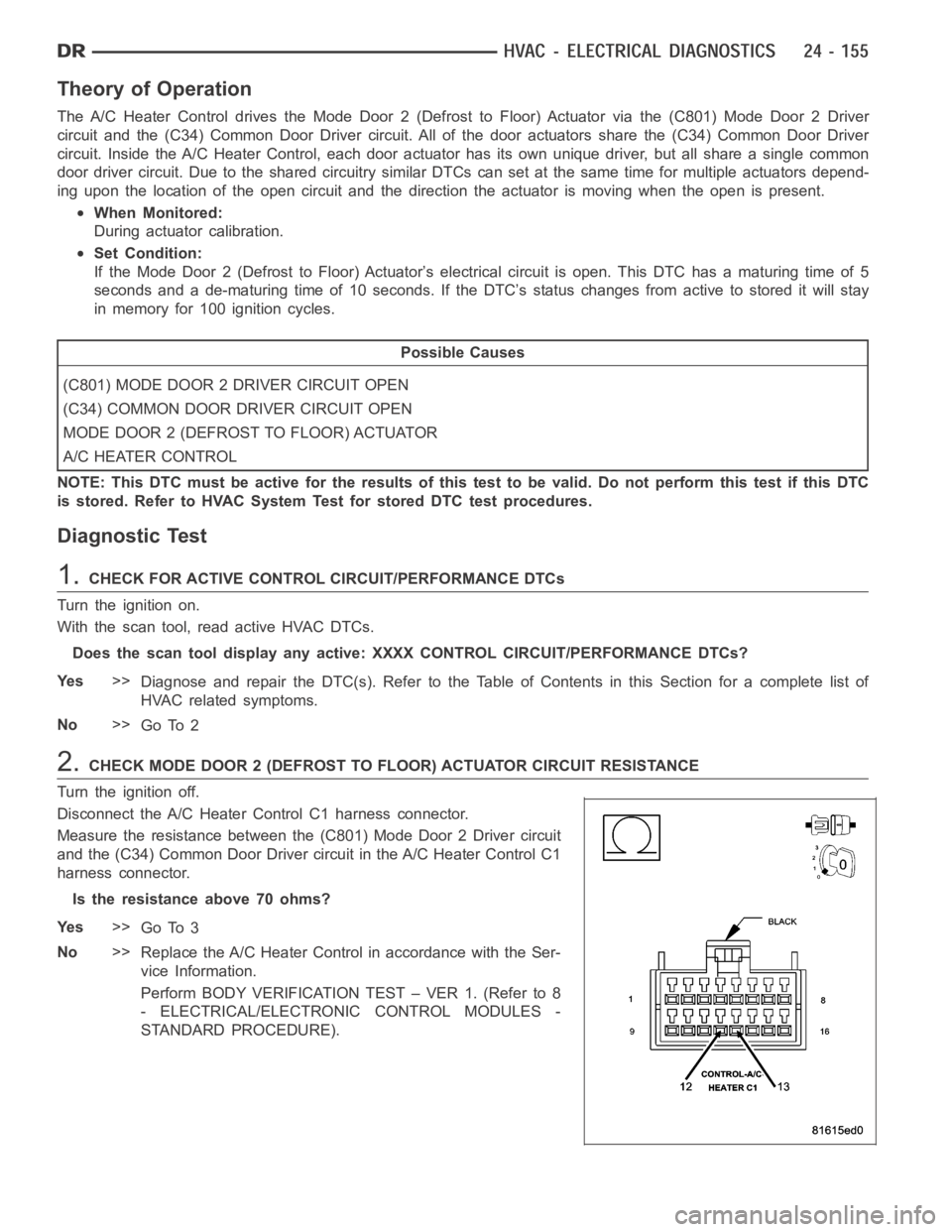
Theory of Operation
The A/C Heater Control drives the Mode Door 2 (Defrost to Floor) Actuator viathe(C801)ModeDoor2Driver
circuit and the (C34) Common Door Driver circuit. All of the door actuatorsshare the (C34) Common Door Driver
circuit. Inside the A/C Heater Control, each door actuator has its own unique driver, but all share a single common
door driver circuit. Due to the shared circuitry similar DTCs can set at thesame time for multiple actuators depend-
ing upon the location of the open circuit and the direction the actuator is moving when the open is present.
When Monitored:
During actuator calibration.
Set Condition:
If the Mode Door 2 (Defrost to Floor) Actuator’s electrical circuit is open. This DTC has a maturing time of 5
seconds and a de-maturing time of 10 seconds. If the DTC’s status changes from active to stored it will stay
in memory for 100 ignition cycles.
Possible Causes
(C801) MODE DOOR 2 DRIVER CIRCUIT OPEN
(C34) COMMON DOOR DRIVER CIRCUIT OPEN
MODE DOOR 2 (DEFROST TO FLOOR) ACTUATOR
A/C HEATER CONTROL
NOTE: This DTC must be active for the results of this test to be valid. Do not perform this test if this DTC
is stored. Refer to HVAC System Test for stored DTC test procedures.
Diagnostic Test
1.CHECK FOR ACTIVE CONTROL CIRCUIT/PERFORMANCE DTCs
Turn the ignition on.
With the scan tool, read active HVAC DTCs.
Does the scan tool display any active: XXXX CONTROL CIRCUIT/PERFORMANCE DTCs?
Ye s>>
Diagnose and repair the DTC(s). Refer to the Table of Contents in this Section for a complete list of
HVAC related symptoms.
No>>
Go To 2
2.CHECK MODE DOOR 2 (DEFROST TO FLOOR) ACTUATOR CIRCUIT RESISTANCE
Turn the ignition off.
Disconnect the A/C Heater Control C1 harness connector.
Measure the resistance between the (C801) Mode Door 2 Driver circuit
and the (C34) Common Door Driver circuit in the A/C Heater Control C1
harness connector.
Is the resistance above 70 ohms?
Ye s>>
Go To 3
No>>
Replace the A/C Heater Control in accordance with the Ser-
vice Information.
Perform BODY VERIFICATION TEST – VER 1. (Refer to 8
- ELECTRICAL/ELECTRONIC CONTROL MODULES -
STANDARD PROCEDURE).
Page 4999 of 5267
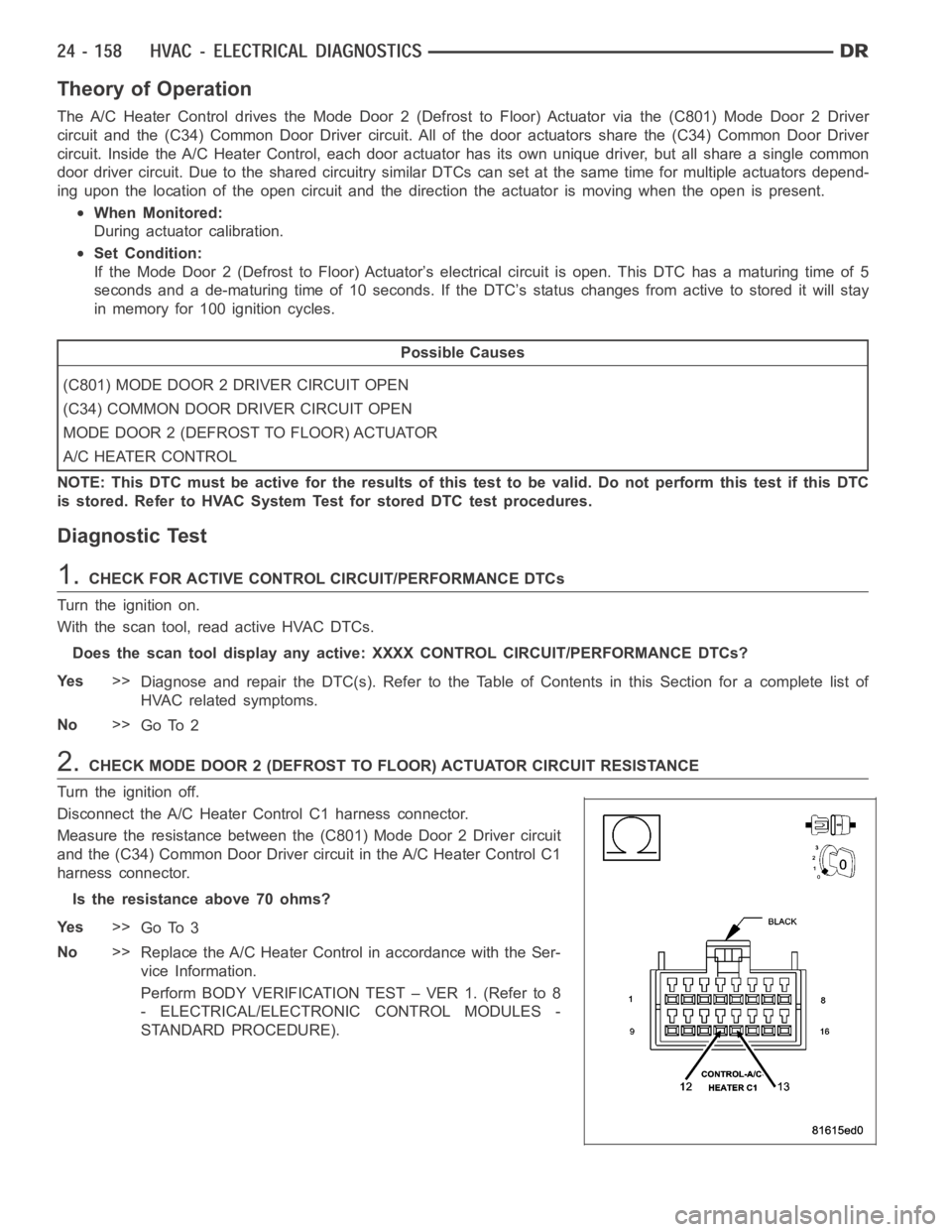
Theory of Operation
The A/C Heater Control drives the Mode Door 2 (Defrost to Floor) Actuator viathe(C801)ModeDoor2Driver
circuit and the (C34) Common Door Driver circuit. All of the door actuatorsshare the (C34) Common Door Driver
circuit. Inside the A/C Heater Control, each door actuator has its own unique driver, but all share a single common
door driver circuit. Due to the shared circuitry similar DTCs can set at thesame time for multiple actuators depend-
ing upon the location of the open circuit and the direction the actuator is moving when the open is present.
When Monitored:
During actuator calibration.
Set Condition:
If the Mode Door 2 (Defrost to Floor) Actuator’s electrical circuit is open. This DTC has a maturing time of 5
seconds and a de-maturing time of 10 seconds. If the DTC’s status changes from active to stored it will stay
in memory for 100 ignition cycles.
Possible Causes
(C801) MODE DOOR 2 DRIVER CIRCUIT OPEN
(C34) COMMON DOOR DRIVER CIRCUIT OPEN
MODE DOOR 2 (DEFROST TO FLOOR) ACTUATOR
A/C HEATER CONTROL
NOTE: This DTC must be active for the results of this test to be valid. Do not perform this test if this DTC
is stored. Refer to HVAC System Test for stored DTC test procedures.
Diagnostic Test
1.CHECK FOR ACTIVE CONTROL CIRCUIT/PERFORMANCE DTCs
Turn the ignition on.
With the scan tool, read active HVAC DTCs.
Does the scan tool display any active: XXXX CONTROL CIRCUIT/PERFORMANCE DTCs?
Ye s>>
Diagnose and repair the DTC(s). Refer to the Table of Contents in this Section for a complete list of
HVAC related symptoms.
No>>
Go To 2
2.CHECK MODE DOOR 2 (DEFROST TO FLOOR) ACTUATOR CIRCUIT RESISTANCE
Turn the ignition off.
Disconnect the A/C Heater Control C1 harness connector.
Measure the resistance between the (C801) Mode Door 2 Driver circuit
and the (C34) Common Door Driver circuit in the A/C Heater Control C1
harness connector.
Is the resistance above 70 ohms?
Ye s>>
Go To 3
No>>
Replace the A/C Heater Control in accordance with the Ser-
vice Information.
Perform BODY VERIFICATION TEST – VER 1. (Refer to 8
- ELECTRICAL/ELECTRONIC CONTROL MODULES -
STANDARD PROCEDURE).
Page 5001 of 5267
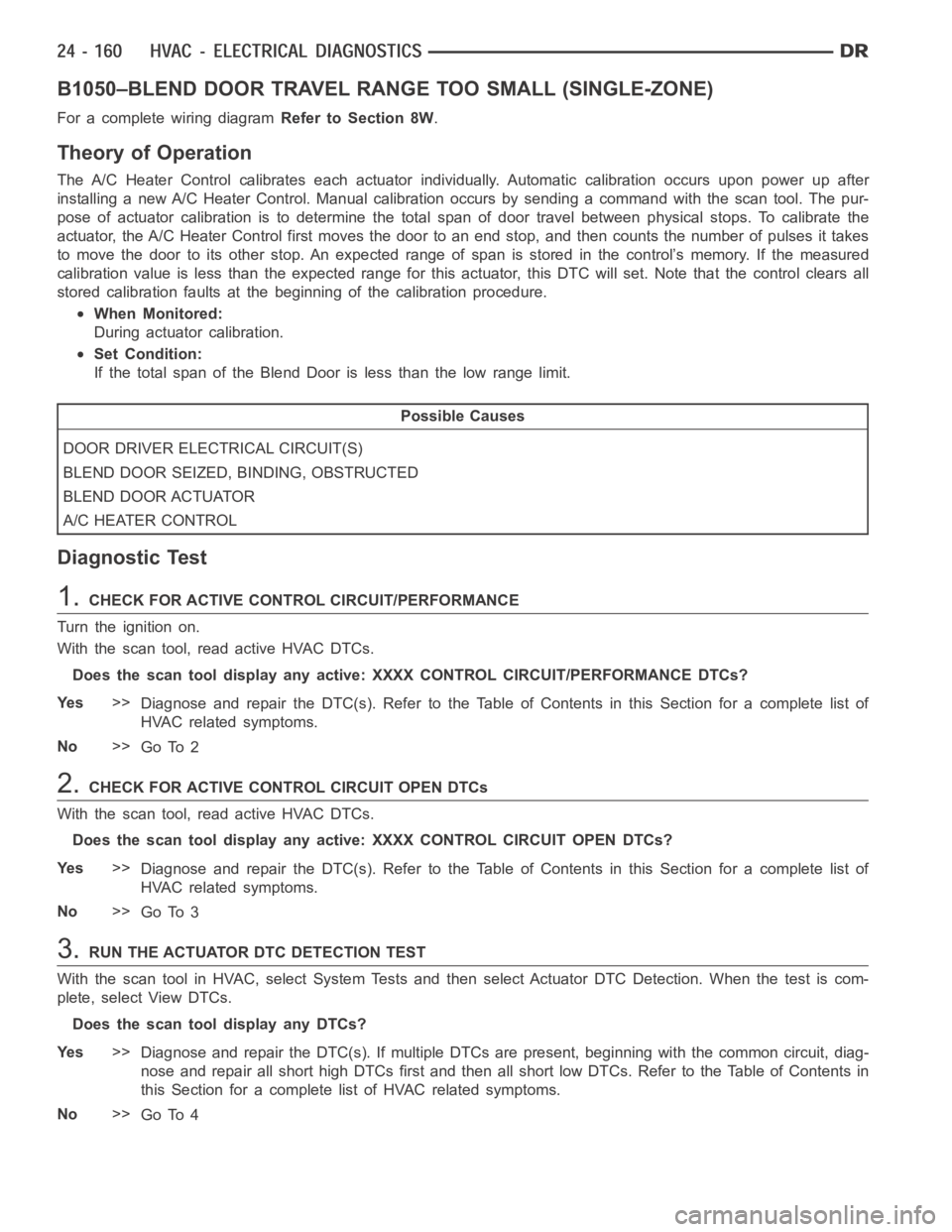
B1050–BLEND DOOR TRAVEL RANGE TOO SMALL (SINGLE-ZONE)
For a complete wiring diagramRefer to Section 8W.
Theory of Operation
The A/C Heater Control calibrates each actuator individually. Automaticcalibration occurs upon power up after
installing a new A/C Heater Control. Manual calibration occurs by sendinga command with the scan tool. The pur-
pose of actuator calibration is to determine the total span of door travel between physical stops. To calibrate the
actuator, the A/C Heater Control first moves the door to an end stop, and then counts the number of pulses it takes
to move the door to its other stop. An expected range of span is stored in the control’s memory. If the measured
calibration value is less than the expected range for this actuator, this DTC will set. Note thatthe control clears all
stored calibration faults at the beginning of the calibration procedure.
When Monitored:
During actuator calibration.
Set Condition:
If the total span of the Blend Door is less than the low range limit.
Possible Causes
DOOR DRIVER ELECTRICAL CIRCUIT(S)
BLEND DOOR SEIZED, BINDING, OBSTRUCTED
BLEND DOOR ACTUATOR
A/C HEATER CONTROL
Diagnostic Test
1.CHECK FOR ACTIVE CONTROL CIRCUIT/PERFORMANCE
Turn the ignition on.
With the scan tool, read active HVAC DTCs.
Does the scan tool display any active: XXXX CONTROL CIRCUIT/PERFORMANCE DTCs?
Ye s>>
Diagnose and repair the DTC(s). Refer to the Table of Contents in this Section for a complete list of
HVAC related symptoms.
No>>
Go To 2
2.CHECK FOR ACTIVE CONTROL CIRCUIT OPEN DTCs
With the scan tool, read active HVAC DTCs.
Does the scan tool display any active: XXXX CONTROL CIRCUIT OPEN DTCs?
Ye s>>
Diagnose and repair the DTC(s). Refer to the Table of Contents in this Section for a complete list of
HVAC related symptoms.
No>>
Go To 3
3.RUN THE ACTUATOR DTC DETECTION TEST
With the scan tool in HVAC, select System Tests and then select Actuator DTCDetection. When the test is com-
plete, select View DTCs.
Does the scan tool display any DTCs?
Ye s>>
Diagnose and repair the DTC(s). If multiple DTCs are present, beginning with the common circuit, diag-
nose and repair all short high DTCs first and then all short low DTCs. Refer to the Table of Contents in
this Section for a complete list of HVAC related symptoms.
No>>
Go To 4
Page 5002 of 5267
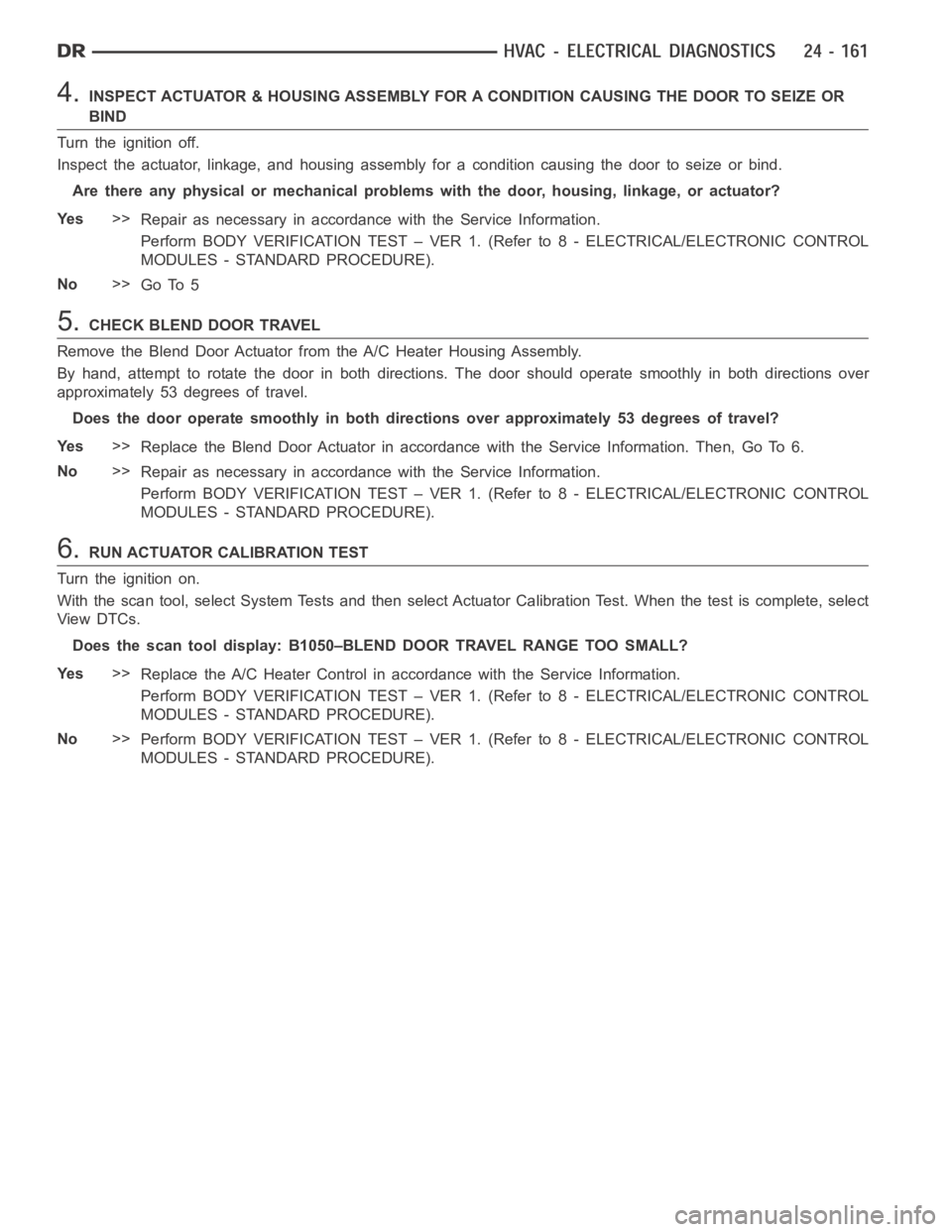
4.INSPECT ACTUATOR & HOUSING ASSEMBLY FOR A CONDITION CAUSING THE DOOR TO SEIZE OR
BIND
Turn the ignition off.
Inspect the actuator, linkage, and housing assembly for a condition causing the door to seize or bind.
Are there any physical or mechanical problems with the door, housing, linkage, or actuator?
Ye s>>
Repair as necessary in accordance with the Service Information.
Perform BODY VERIFICATION TEST – VER 1. (Refer to 8 - ELECTRICAL/ELECTRONIC CONTROL
MODULES - STANDARD PROCEDURE).
No>>
Go To 5
5.CHECK BLEND DOOR TRAVEL
Remove the Blend Door Actuator from the A/C Heater Housing Assembly.
By hand, attempt to rotate the door in both directions. The door should operate smoothly in both directions over
approximately 53 degrees of travel.
Does the door operate smoothly in both directions over approximately 53 degrees of travel?
Ye s>>
Replace the Blend Door Actuator in accordance with the Service Information. Then, Go To 6.
No>>
Repair as necessary in accordance with the Service Information.
Perform BODY VERIFICATION TEST – VER 1. (Refer to 8 - ELECTRICAL/ELECTRONIC CONTROL
MODULES - STANDARD PROCEDURE).
6.RUN ACTUATOR CALIBRATION TEST
Turn the ignition on.
With the scan tool, select System Tests and then select Actuator Calibration Test. When the test is complete, select
View DTCs.
Does the scan tool display: B1050–BLEND DOOR TRAVEL RANGE TOO SMALL?
Ye s>>
Replace the A/C Heater Control in accordance with the Service Information.
Perform BODY VERIFICATION TEST – VER 1. (Refer to 8 - ELECTRICAL/ELECTRONIC CONTROL
MODULES - STANDARD PROCEDURE).
No>>
Perform BODY VERIFICATION TEST – VER 1. (Refer to 8 - ELECTRICAL/ELECTRONIC CONTROL
MODULES - STANDARD PROCEDURE).
Page 5003 of 5267
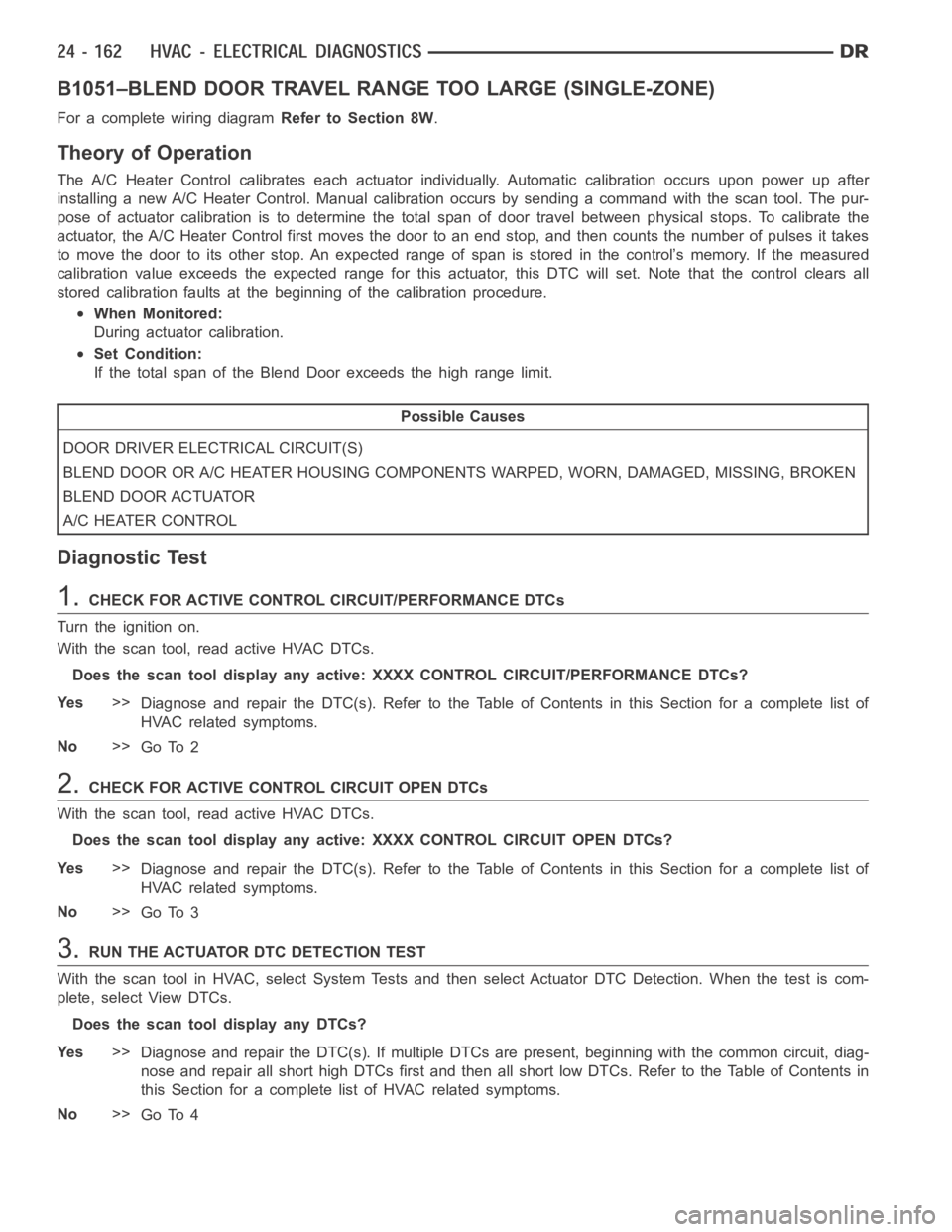
B1051–BLEND DOOR TRAVEL RANGE TOO LARGE (SINGLE-ZONE)
For a complete wiring diagramRefer to Section 8W.
Theory of Operation
The A/C Heater Control calibrates each actuator individually. Automaticcalibration occurs upon power up after
installing a new A/C Heater Control. Manual calibration occurs by sendinga command with the scan tool. The pur-
pose of actuator calibration is to determine the total span of door travel between physical stops. To calibrate the
actuator, the A/C Heater Control first moves the door to an end stop, and then counts the number of pulses it takes
to move the door to its other stop. An expected range of span is stored in the control’s memory. If the measured
calibration value exceeds the expected range for this actuator, this DTC will set. Note that the control clears all
stored calibration faults at the beginning of the calibration procedure.
When Monitored:
During actuator calibration.
Set Condition:
If the total span of the Blend Door exceeds the high range limit.
Possible Causes
DOOR DRIVER ELECTRICAL CIRCUIT(S)
BLENDDOORORA/CHEATERHOUSINGCOMPONENTS WARPED, WORN, DAMAGED, MISSING, BROKEN
BLEND DOOR ACTUATOR
A/C HEATER CONTROL
Diagnostic Test
1.CHECK FOR ACTIVE CONTROL CIRCUIT/PERFORMANCE DTCs
Turn the ignition on.
With the scan tool, read active HVAC DTCs.
Does the scan tool display any active: XXXX CONTROL CIRCUIT/PERFORMANCE DTCs?
Ye s>>
Diagnose and repair the DTC(s). Refer to the Table of Contents in this Section for a complete list of
HVAC related symptoms.
No>>
Go To 2
2.CHECK FOR ACTIVE CONTROL CIRCUIT OPEN DTCs
With the scan tool, read active HVAC DTCs.
Does the scan tool display any active: XXXX CONTROL CIRCUIT OPEN DTCs?
Ye s>>
Diagnose and repair the DTC(s). Refer to the Table of Contents in this Section for a complete list of
HVAC related symptoms.
No>>
Go To 3
3.RUN THE ACTUATOR DTC DETECTION TEST
With the scan tool in HVAC, select System Tests and then select Actuator DTCDetection. When the test is com-
plete, select View DTCs.
Does the scan tool display any DTCs?
Ye s>>
Diagnose and repair the DTC(s). If multiple DTCs are present, beginning with the common circuit, diag-
nose and repair all short high DTCs first and then all short low DTCs. Refer to the Table of Contents in
this Section for a complete list of HVAC related symptoms.
No>>
Go To 4
Page 5004 of 5267

4.CHECK FOR A BROKEN BLEND DOOR ACTUATOR
Turn the ignition off.
Remove the Blend Door Actuator from the A/C Heater Housing Assembly.
By hand, attempt to rotate the actuator in both directions.
Does the actuator turn in either direction?
Ye s>>
Replace the Blend Door Actuator in accordance with the Service Information.
Perform BODY VERIFICATION TEST – VER 1. (Refer to 8 - ELECTRICAL/ELECTRONIC CONTROL
MODULES - STANDARD PROCEDURE).
No>>
Go To 5
5.CHECK BLEND DOOR & A/C HEATER HOUSING FOR WARPED, WORN, DAMAGED, MISSING, &
BROKEN COMPONENTS
Inspect for excessively worn, disconnected, missing, or broken door linkage. Inspect for a damaged or broken A/C
Heater Housing Assembly. Inspect for a warped or broken door, and missing door seals. Rotate the door from stop
to stop. The door should rotate approximately 53 degrees.
Are there any physical or mechanical problems with the door or housing?
Ye s>>
Repair as necessary in accordance with the Service Information.
Perform BODY VERIFICATION TEST – VER 1. (Refer to 8 - ELECTRICAL/ELECTRONIC CONTROL
MODULES - STANDARD PROCEDURE).
No>>
Replace the Blend Door Actuator in accordance with the Service Information. Then, Go To 6.
6.RUN ACTUATOR CALIBRATION TEST
Turn the ignition on.
With the scan tool, select System Tests and then select Actuator Calibration Test. When the test is complete, select
View DTCs.
Does the scan tool display: B1051–BLEND DOOR TRAVEL RANGE TOO LARGE?
Ye s>>
Replace the A/C Heater Control in accordance with the Service Information.
Perform BODY VERIFICATION TEST – VER 1. (Refer to 8 - ELECTRICAL/ELECTRONIC CONTROL
MODULES - STANDARD PROCEDURE).
No>>
Perform BODY VERIFICATION TEST – VER 1. (Refer to 8 - ELECTRICAL/ELECTRONIC CONTROL
MODULES - STANDARD PROCEDURE).
Page 5009 of 5267
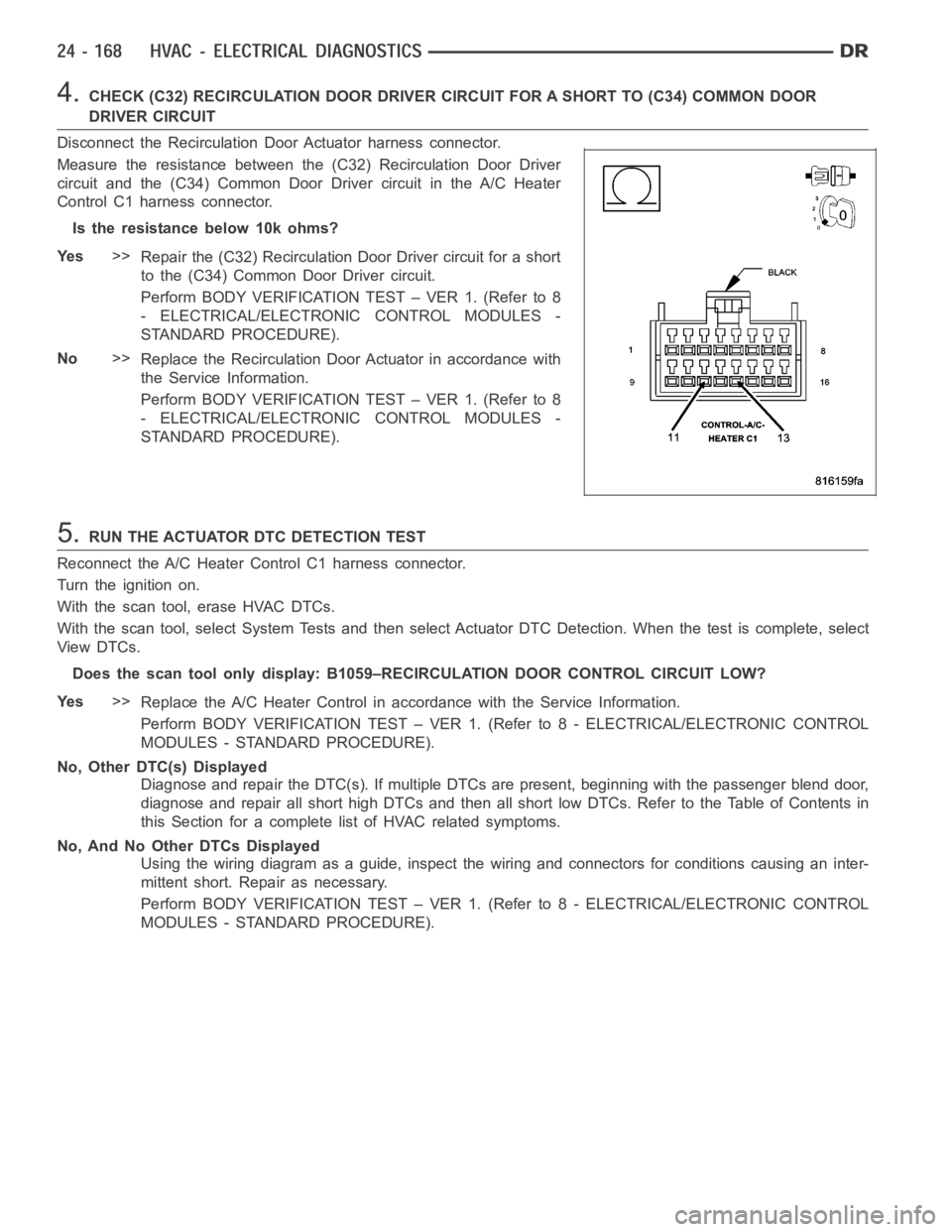
4.CHECK (C32) RECIRCULATION DOOR DRIVERCIRCUIT FOR A SHORT TO (C34) COMMON DOOR
DRIVER CIRCUIT
Disconnect the Recirculation Door Actuator harness connector.
Measure the resistance between the (C32) Recirculation Door Driver
circuit and the (C34) Common Door Driver circuit in the A/C Heater
Control C1 harness connector.
Istheresistancebelow10kohms?
Ye s>>
Repair the (C32) Recirculation Door Driver circuit for a short
to the (C34) Common DoorDrivercircuit.
Perform BODY VERIFICATION TEST – VER 1. (Refer to 8
- ELECTRICAL/ELECTRONIC CONTROL MODULES -
STANDARD PROCEDURE).
No>>
Replace the Recirculation Door Actuator in accordance with
the Service Information.
Perform BODY VERIFICATION TEST – VER 1. (Refer to 8
- ELECTRICAL/ELECTRONIC CONTROL MODULES -
STANDARD PROCEDURE).
5.RUN THE ACTUATOR DTC DETECTION TEST
Reconnect the A/C Heater Control C1 harness connector.
Turn the ignition on.
With the scan tool, erase HVAC DTCs.
With the scan tool, select System Tests and then select Actuator DTC Detection. When the test is complete, select
View DTCs.
Does the scan tool only display: B1059–RECIRCULATION DOOR CONTROL CIRCUITLOW?
Ye s>>
Replace the A/C Heater Control in accordance with the Service Information.
Perform BODY VERIFICATION TEST – VER 1. (Refer to 8 - ELECTRICAL/ELECTRONIC CONTROL
MODULES - STANDARD PROCEDURE).
No, Other DTC(s) Displayed
Diagnose and repair the DTC(s). If multiple DTCs are present, beginning with the passenger blend door,
diagnose and repair all short high DTCs and then all short low DTCs. Refer tothe Table of Contents in
this Section for a complete list of HVAC related symptoms.
No, And No Other DTCs Displayed
Using the wiring diagram as a guide, inspect the wiring and connectors for conditions causing an inter-
mittent short. Repair as necessary.
Perform BODY VERIFICATION TEST – VER 1. (Refer to 8 - ELECTRICAL/ELECTRONIC CONTROL
MODULES - STANDARD PROCEDURE).
Page 5013 of 5267
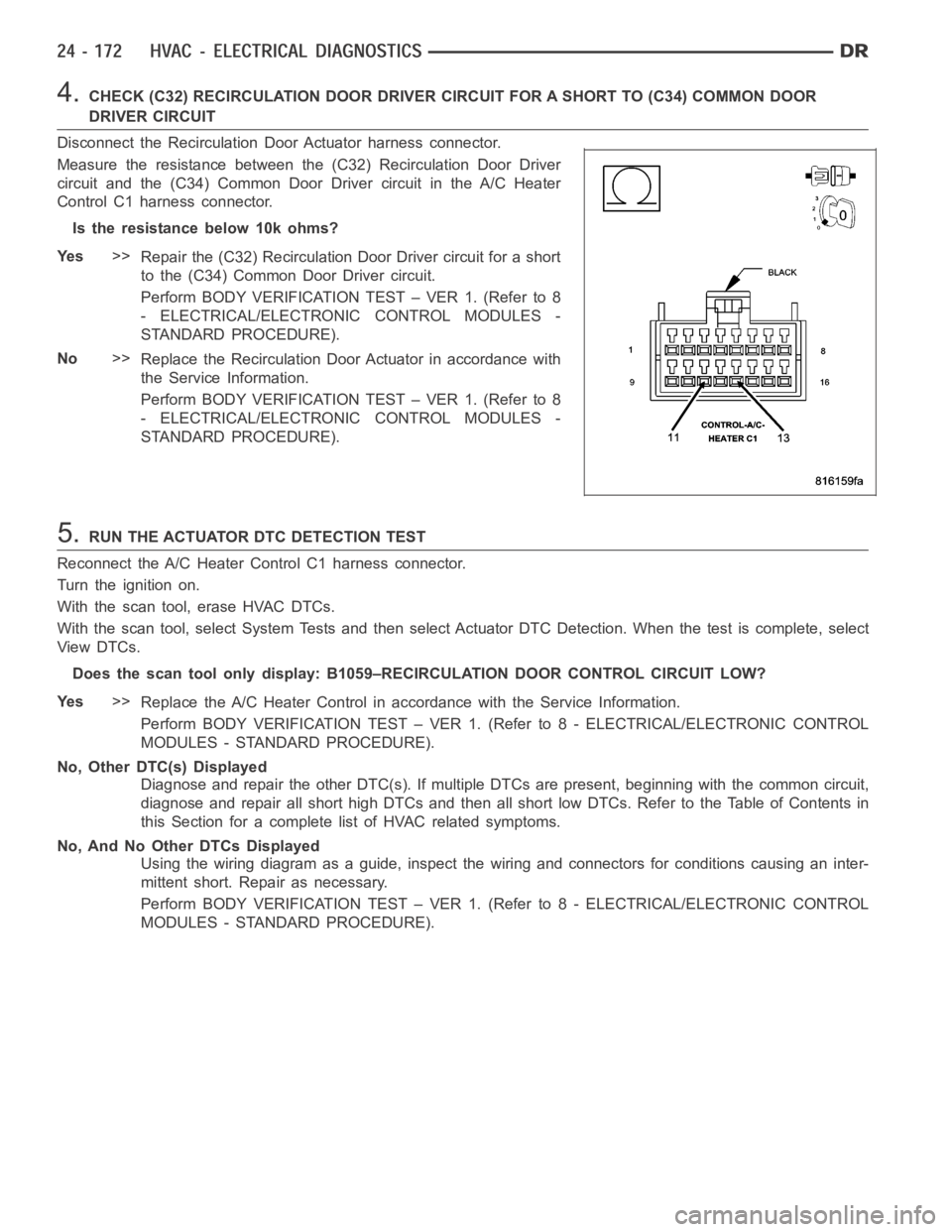
4.CHECK (C32) RECIRCULATION DOOR DRIVERCIRCUIT FOR A SHORT TO (C34) COMMON DOOR
DRIVER CIRCUIT
Disconnect the Recirculation Door Actuator harness connector.
Measure the resistance between the (C32) Recirculation Door Driver
circuit and the (C34) Common Door Driver circuit in the A/C Heater
Control C1 harness connector.
Istheresistancebelow10kohms?
Ye s>>
Repair the (C32) Recirculation Door Driver circuit for a short
to the (C34) Common DoorDrivercircuit.
Perform BODY VERIFICATION TEST – VER 1. (Refer to 8
- ELECTRICAL/ELECTRONIC CONTROL MODULES -
STANDARD PROCEDURE).
No>>
Replace the Recirculation Door Actuator in accordance with
the Service Information.
Perform BODY VERIFICATION TEST – VER 1. (Refer to 8
- ELECTRICAL/ELECTRONIC CONTROL MODULES -
STANDARD PROCEDURE).
5.RUN THE ACTUATOR DTC DETECTION TEST
Reconnect the A/C Heater Control C1 harness connector.
Turn the ignition on.
With the scan tool, erase HVAC DTCs.
With the scan tool, select System Tests and then select Actuator DTC Detection. When the test is complete, select
View DTCs.
Does the scan tool only display: B1059–RECIRCULATION DOOR CONTROL CIRCUITLOW?
Ye s>>
Replace the A/C Heater Control in accordance with the Service Information.
Perform BODY VERIFICATION TEST – VER 1. (Refer to 8 - ELECTRICAL/ELECTRONIC CONTROL
MODULES - STANDARD PROCEDURE).
No, Other DTC(s) Displayed
Diagnose and repair the other DTC(s). If multiple DTCs are present, beginning with the common circuit,
diagnose and repair all short high DTCs and then all short low DTCs. Refer tothe Table of Contents in
this Section for a complete list of HVAC related symptoms.
No, And No Other DTCs Displayed
Using the wiring diagram as a guide, inspect the wiring and connectors for conditions causing an inter-
mittent short. Repair as necessary.
Perform BODY VERIFICATION TEST – VER 1. (Refer to 8 - ELECTRICAL/ELECTRONIC CONTROL
MODULES - STANDARD PROCEDURE).